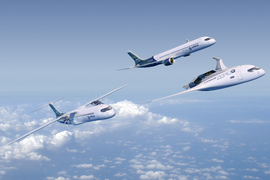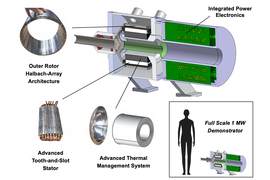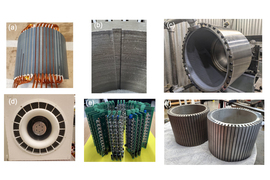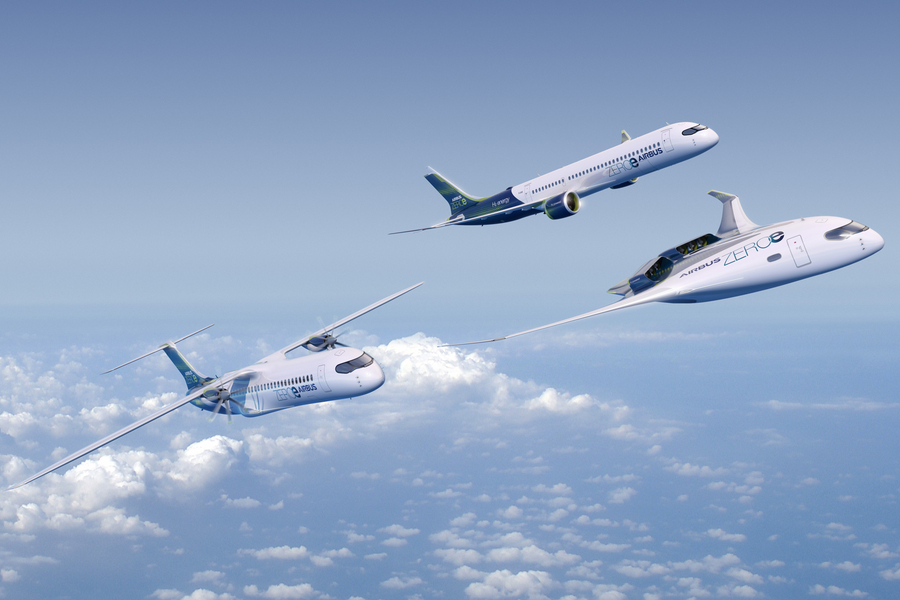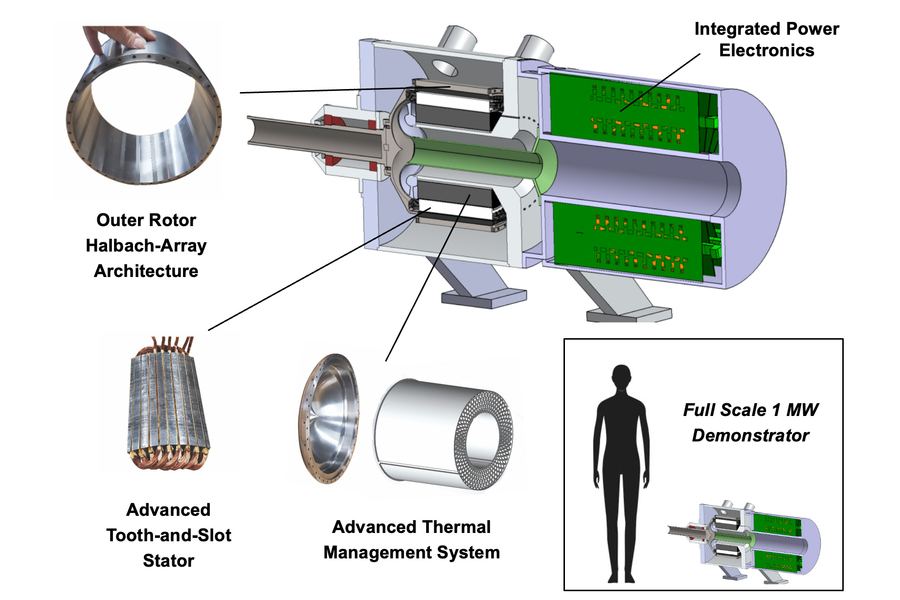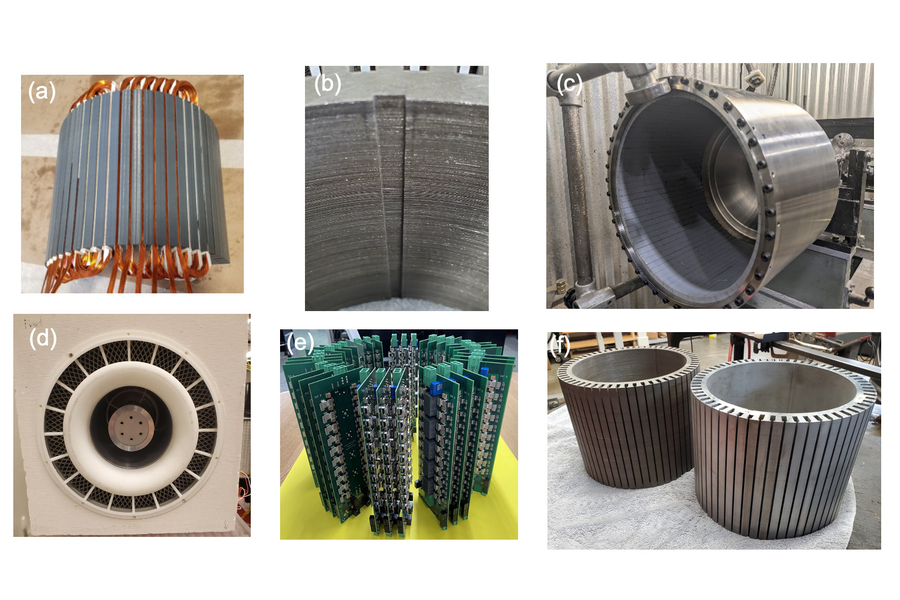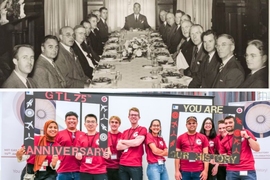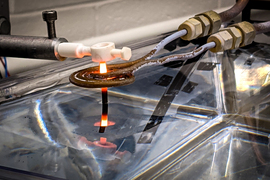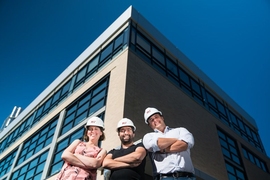Aviation’s huge carbon footprint could shrink significantly with electrification. To date, however, only small all-electric planes have gotten off the ground. Their electric motors generate hundreds of kilowatts of power. To electrify larger, heavier jets, such as commercial airliners, megawatt-scale motors are required. These would be propelled by hybrid or turbo-electric propulsion systems where an electrical machine is coupled with a gas turbine aero-engine.
To meet this need, a team of MIT engineers is now creating a 1-megawatt motor that could be a key stepping stone toward electrifying larger aircraft. The team has designed and tested the major components of the motor, and shown through detailed computations that the coupled components can work as a whole to generate one megawatt of power, at a weight and size competitive with current small aero-engines.
For all-electric applications, the team envisions the motor could be paired with a source of electricity such as a battery or a fuel cell. The motor could then turn the electrical energy into mechanical work to power a plane’s propellers. The electrical machine could also be paired with a traditional turbofan jet engine to run as a hybrid propulsion system, providing electric propulsion during certain phases of a flight.
“No matter what we use as an energy carrier — batteries, hydrogen, ammonia, or sustainable aviation fuel — independent of all that, megawatt-class motors will be a key enabler for greening aviation,” says Zoltan Spakovszky, the T. Wilson Professor in Aeronautics and the Director of the Gas Turbine Laboratory (GTL) at MIT, who leads the project.
Spakovszky and members of his team, along with industry collaborators, will present their work at a special session of the American Institute of Aeronautics and Astronautics – Electric Aircraft Technologies Symposium (EATS) at the Aviation conference in June.
The MIT team is composed of faculty, students, and research staff from GTL and the MIT Laboratory for Electromagnetic and Electronic Systems: Henry Andersen Yuankang Chen, Zachary Cordero, David Cuadrado, Edward Greitzer, Charlotte Gump, James Kirtley, Jr., Jeffrey Lang, David Otten, David Perreault, and Mohammad Qasim, along with Marc Amato of Innova-Logic LLC. The project is sponsored by Mitsubishi Heavy Industries (MHI).
Heavy stuff
To prevent the worst impacts from human-induced climate change, scientists have determined that global emissions of carbon dioxide must reach net zero by 2050. Meeting this target for aviation, Spakovszky says, will require “step-change achievements” in the design of unconventional aircraft, smart and flexible fuel systems, advanced materials, and safe and efficient electrified propulsion. Multiple aerospace companies are focused on electrified propulsion and the design of megawatt-scale electric machines that are powerful and light enough to propel passenger aircraft.
“There is no silver bullet to make this happen, and the devil is in the details,” Spakovszky says. “This is hard engineering, in terms of co-optimizing individual components and making them compatible with each other while maximizing overall performance. To do this means we have to push the boundaries in materials, manufacturing, thermal management, structures and rotordynamics, and power electronics”
Broadly speaking, an electric motor uses electromagnetic force to generate motion. Electric motors, such as those that power the fan in your laptop, use electrical energy — from a battery or power supply — to generate a magnetic field, typically through copper coils. In response, a magnet, set near the coils, then spins in the direction of the generated field and can then drive a fan or propeller.
Electric machines have been around for over 150 years, with the understanding that, the bigger the appliance or vehicle, the larger the copper coils and the magnetic rotor, making the machine heavier. The more power the electrical machine generates, the more heat it produces, which requires additional elements to keep the components cool — all of which can take up space and add significant weight to the system, making it challenging for airplane applications.
“Heavy stuff doesn’t go on airplanes,” Spakovszky says. “So we had to come up with a compact, lightweight, and powerful architecture.”
Good trajectory
As designed, the MIT electric motor and power electronics are each about the size of a checked suitcase weighing less than an adult passenger.
The motor’s main components are: a high-speed rotor, lined with an array of magnets with varying orientation of polarity; a compact low-loss stator that fits inside the rotor and contains an intricate array of copper windings; an advanced heat exchanger that keeps the components cool while transmitting the torque of the machine; and a distributed power electronics system, made from 30 custom-built circuit boards, that precisely change the currents running through each of the stator’s copper windings, at high frequency.
“I believe this is the first truly co-optimized integrated design,” Spakovszky says. “Which means we did a very extensive design space exploration where all considerations from thermal management, to rotor dynamics, to power electronics and electrical machine architecture were assessed in an integrated way to find out what is the best possible combination to get the required specific power at one megawatt.”
As a whole system, the motor is designed such that the distributed circuit boards are close coupled with the electrical machine to minimize transmission loss and to allow effective air cooling through the integrated heat exchanger.
“This is a high-speed machine, and to keep it rotating while creating torque, the magnetic fields have to be traveling very quickly, which we can do through our circuit boards switching at high frequency,” Spakovszky says.
To mitigate risk, the team has built and tested each of the major components individually, and shown that they can operate as designed and at conditions exceeding normal operational demands. The researchers plan to assemble the first fully working electric motor, and start testing it in the fall.
“The electrification of aircraft has been on a steady rise,” says Phillip Ansell, director of the Center for Sustainable Aviation at the University of Illinois Urbana-Champaign, who was not involved in the project. “This group’s design uses a wonderful combination of conventional and cutting-edge methods for electric machine development, allowing it to offer both robustness and efficiency to meet the practical needs of aircraft of the future.”
Once the MIT team can demonstrate the electric motor as a whole, they say the design could power regional aircraft and could also be a companion to conventional jet engines, to enable hybrid-electric propulsion systems. The team also envision that multiple one-megawatt motors could power multiple fans distributed along the wing on future aircraft configurations. Looking ahead, the foundations of the one-megawatt electrical machine design could potentially be scaled up to multi-megawatt motors, to power larger passenger planes.
“I think we’re on a good trajectory,” says Spakovszky, whose group and research have focused on more than just gas turbines. “We are not electrical engineers by training, but addressing the 2050 climate grand challenge is of utmost importance; working with electrical engineering faculty, staff and students for this goal can draw on MIT’s breadth of technologies so the whole is greater than the sum of the parts. So we are reinventing ourselves in new areas. And MIT gives you the opportunity to do that.”
